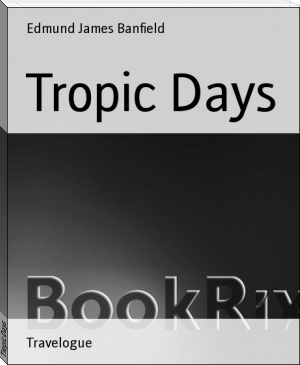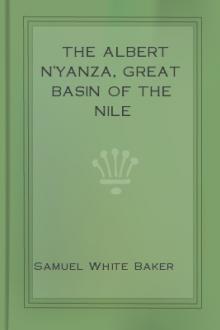Confessions of a Beachcomber, Edmund James Banfield [easy readers txt] 📗

- Author: Edmund James Banfield
Book online «Confessions of a Beachcomber, Edmund James Banfield [easy readers txt] 📗». Author Edmund James Banfield
In birds and in mammals and in plants, wide-spread Australian groups are unrepresented.
THE DAYBREAK FUGUE
Before there is any visible sign of the break of day, some keener and finer perception than man possesses reveals it to the noisy pitta, or dragoon bird, which in duty bound makes prompt proclamation. Man trusts to mechanism to check off the watches of the night; birds to a self-contained grace more sensitive if not so viciously exact. The noisy pitta bustles along the edge of the jungle rousing all the sleepy heads with sharp interrogative whistles before there is the least paling of the Eastern sky. He scents the sun as the ghost of Hamlet's father the morning air. His version of "Sleepers, wake," echoes in the silence in sharp, staccato notes. Seldom heard during the heat of the day, they are oft repeated at dusk and late in the evening. Of all the birds of the day his voice is the last as well as the first, and from that the natives derive his name, "Wung-go-bah."
As the dawn hastens a subdued fugue of chirps and whistles, soft, continuous and quite distinct from the cheerful individual notes and calls with which the glare is greeted, completes a circle of sounds. Wheresoever he stands the listener is in the centre of ripples of melody which blend with the silence almost as speedily as the half lights flee before the pompous rays of the imperial sun. This charming melody is but a general exclamation of pleasure on the recovery of the day from the apprehension of the night, a mutual recognition, an interchange of matutinal compliments. Those who take part in it may be jealous rivals in a few minutes, but the first impulse of each new day is a universal paean, not loud and vaunting, but mellow, sweet and unselfish.
THE MEGAPODE
The cackle and call of the scrub fowl (MEGAPODIUS DUPERREYS) are nocturnal as well as sounds of the day, being repeated at intervals all through the night. Rarely venturing out of the shades of the jungle, the eyesight of this bird is, no doubt, specially adjusted to darkness and subdued lights, and is thus enabled to detect and prey upon insects which during the day lurk under leaves and decayed wood, or bury themselves in the surface of the ever moist soil. Astonishment is excited that there can by any possibility be any grubs or beetles, centipedes and worms, scorpions and spiders left to perpetuate their species, when the floor of the jungle is raked over with such assiduity by this powerful and active bird. During the day the megapode is sometimes silent, but ever and anon it gives way to what may in charity be presumed to be a crow---an uncouth, discordant effort to imitate the boastful, tuneful challenge of the civilised rooster. In common with "Elia" (and others) the megapode has no ear for music. It seems to have been practising "cock-a-doodle-doo" all its life in the solitary corners and undergrowth, and to have not yet arrived within quavers of it. It "abhors the measured malice of music."
The inclusion among the birds of the air of such an inveterate land lover, a bird which seldom takes flight of its own motive, is permissible on general principles, while its practical exercise of rare domestic economy entitles it to special and complimentary notice. Reference is made elsewhere to the surpassing intelligence of the megapode in taking advantage of the heat caused by the fermentation of decaying vegetation to hatch out huge eggs. Long before the astute Chinese practised the artificial incubation of hens' and ducks' eggs, these sage birds of ours had mastered it. Several birds seem to co-operate in the building of a mound, which may contain many cartloads of material, but each bird appears to have a particular area in which to deposit her eggs. The chicks apparently earn their own living immediately they emerge fully fledged from the mound, and are so far independent of maternal care that they are sometimes found long distances from the nearest possible birthplace, scratching away vigorously and flying when frightened with remarkable vigour and speed, though but a few hours old. I come gladly to the conclusion that the megapode is a sagacious bird, not only in the avoidance of the dismal duty of incubation, but in respect of the making of those great mounds of decaying vegetable matter and earth which perform the function so effectively. In a particularly rugged part of the island is a mound almost completely walled in by immense boulders. In such a situation the birds could hardly have found it possible to accumulate by kicking and scratching so great a quantity of debris. The material was not available on the site, and as the makers do not carry their rubbish, it was puzzling to account for it all, until it was noticed that the junction of two boulders with an inclination towards each other formed a natural flume or shoot down which most of the material of the mound had been sent. As the rains and use flatten the apex fresh stuff is deposited with a trifling amount of labour, to afford an illustration of "purposive conscious action."
The megapode seems to delight in flying in the face of laws to which ordinary fowls are obedient. While making a law unto herself for the incubation of eggs, she scandalously violates that which provides that the size of the egg shall be in proportion to the size of the bird. Though much less in weight than an average domestic fowl, the egg that she lays equals nearly three of the fowl's. Comparisons between the egg of the cassowary (one of the giants among birds) and of the common fowl with that of the megapode, are highly complimentary to the latter. A fair weight for a full-grown cassowary is 150 lb., and the egg weighs 1 lb. 6 oz. A good-conditioned megapode weighs 3 lb., the egg 5 1/4 oz.; ordinary domestic fowl, 4 lb., egg 2 oz. The egg of the cassowary represents 1 per cent. of the weight of the bird, the domestic fowl's 3 1/8 per cent., and that of megapode no less than 11 1/2 per cent of its weight.
When these facts are considered, we realise why the homey head of the great cassowary, the layer of the largest of Australian eggs, is carried so low as she bursts through the jungle; why the pair converse in such humble tones and why, on the other hand, the megapode exults so loudly so coarsely and in such shocking intervals, careless of the sentiments and of the sense of melody of every other bird.
Though the powers of the flight of this bird are feeble it inhabits islands 3 and 4 miles further out to sea than their most adjacent neighbours. The laboured way in which a startled bird flies across the narrow expanse of my plantation proves that a long journey would never be undertaken voluntarily. Not many months ago some blacks walking on the beach on the mainland had their attention attracted by a bird flying low on the water from the direction of Dunk Island, 2 1/2 miles away. It was labouring heavily, and some little distance from land fell exhausted into the sea. When it drifted ashore--a godsend to the boys--it was found to be a megapode--and the feat was camp talk. None could credit that a "kee-rowan" could fly so far.
SWAMP PHEASANT
The swamp pheasant, or pheasant coucal (CENTROPUS PHASIANUS) is also an early bird, and a bird of varied linguistic capabilities. Folks are apt to associate with him but one note, and that resembling the mellow gurgle of cream from a bottle, "Glooc! glooc! glooc! glooc!" An intimate knowledge of his conversational powers leads one to conclude that there are few birds more widely accomplished in that direction. He does use the fluid phrase mentioned, but his notes and those of his consort cover quite a range of exclamations and calls. Just as I write a pair appeal for a just recognition of their accomplishments. That which I assume to be the lord and master utters a loud resonant "Toom! toom! toom! toom" a smooth trombonic sound, "hollow to the reverberate hills," which his consort answers with a series of "Tum! tum tum! tum!" on a higher but still harmonious key, and in accelerated tempo. This, I fancy, is the lover's serenade, and the soft assenting answer; almost invariably the loud hollow sound is the opening phrase of the duet. "Sole or responsive to each other's note," the birds make the forest resound again during the day, especially in the prime months, and even these notes find varied and pleasing expression. Free and joyous as a rule, occasionally they seem to indicate sadness and gloom. During and after a bush fire the birds give to the notes a mournful cadence like the memories of joy that are past, a lament for the destruction of the grass among which last year's dome-shaped nests were hidden. The swamp pheasant also utters a contented, self-complacent chuckle, that resembles the "Goo! goo! goo!" of a happy infant, and occasionally a succession of grating, discordant, mocking sounds, "Tcharn! tcharn! tcharn!" The chuckle may be an expression as if gloating over the detection and assimilation of some favourite dainty, and the harsh notes a demonstration of rivalry, anger and hostility. The more familiar and more frequent note is the "Toom," repeated about fourteen or sixteen times, and the thinner, softer response.
The bird resembles in plumage a pheasant. Cumbersome and slow of flight, clumsy in alighting, he frequently loses his equilibrium, and is compelled to use his long tail as a counter-balance, as he jumps from branch to branch ascending a tree, in order to gain elevation, whence to swoop and flop across the intervening space to the next. When compelled to take wing from a low elevation, the flight is slow and laboured in the extreme. He is a handsome fellow, the ruling colours being glossy black, brown and reddish chestnut. One writer describes the bird as half hawk, half pheasant, another as a non-parasitic cuckoo; another "really a cuckoo"; another a swamp or tree parrot with the foot of a lark. Without daring to attempt to dispute any of these descriptions, I may say that the bird is a decided character and possesses the charm of originality. He has become so confiding that he will perch on the gatepost as one enters, assuming a fierce and resentful aspect, and he will play "hawk" to the startled fowls. He eats the eggs of other birds and kills chicks; but his murderous instincts are rarely exhibited, and then only, perhaps, when his passions are aroused. He does not (as far as my observation goes) kill for food, but merely because Nature gives him at certain times and seasons a fiery, jealous disposition, and a truculent determination to protect his family.
"GO-BIDGER-ROO!"
As the sun shines over the range, the plaintive cooing of the little blue dove, such as picked the rice grains from the bowl beside





Comments (0)